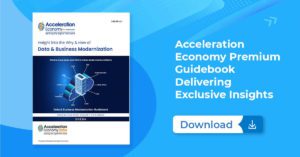
In episode 49 of the Data Modernization Minute, Wayne Sadin examines modern ERP and its advantages over past ERP systems.
This episode is sponsored by Acceleration Economy’s Digital CIO Summit, taking place April 4-6. Register for the free event here. Tune in to the event to hear from CIO practitioners discuss their modernization and growth strategies.
Highlights
00:39 — Enterprise resource planning (ERP) software systems, a topic Wayne is passionate about, are increasingly relevant given the economic slowdown. Companies are looking to get more out of their existing processes, which puts ERP at the forefront of discussions “as opposed to some of the sexier, cool stuff.”
01:13 — To better understand ERP systems, it’s necessary to understand how they have evolved and what the differences are between modern and old ERP. In the past, ERP was rigid, built out of “huge chunks of codes written … over decades.” When change was necessary, the code had to be rewritten in pieces.
01:51 — Modern ERP is modular, potentially containing horizontal components such as customer relationship management (CRM); accounts payable and receivable; fixed assets; a general ledger, and so on, Wayne explains. Many systems also contain vertical components, which means knowledge of industries like health care, manufacturing, hospitality, or retail “baked right into the code.”
02:25 — The inclusion of these vertical components in modern ERP means that regulatory compliance, industry norms, and standard ways of doing accounting under generally accepted accounting principles (GAAP) or international financial reporting standards (IFRS) are built on top of a database layer. This modern database layer is documented, consistent, and coherent. It does not require experts to use it or to be connected to another analytical database so people can get reports.
02:59 — Workflow, low-code/no-code development language, and robotic process automation (RPA) tools are among a host of products that make modern ERP much easier to use than ERP of the past.
03:23 — Finally, modern ERP is built in the cloud. Companies are no longer responsible for putting in code on larger servers that need to be maintained through new releases. The vendors now put out more frequent releases, but the releases are smaller, and companies’ work implementing these releases is, in most cases, carried along by the vendor code.
03:46 — In conclusion, modern ERP is very different from the old architecture. Look for Part 2 of this modern ERP analysis, where Wayne will discuss what that means for CIOs, CEOs, and boards of directors.
Want more insights into all things data? Visit the Data Modernization channel:









